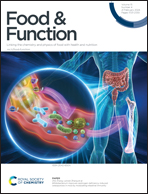Galactooligosaccharides in infant formulas: Maillard reaction characteristics and influence on formation of advanced glycation end products†
Abstract
As prebiotics supplemented in infant formulas (IFs), galactooligosaccharides (GOSs) also have many other biological activities; however, their Maillard reaction characteristics are still unclear. We investigated the Maillard reactivity of GOSs and their effects on advanced glycation end product (AGE) formation during IF processing. The results showed that AGE and HMF formation was temperature-dependent and reached the maximum at pH 9.0 in the Maillard reaction system of GOSs and Nα-acetyl-L-lysine. Acidic conditions accelerated HMF formation; however, protein cross-linking was more likely to occur under alkaline conditions. The degree of polymerization (DP) of GOSs had no significant effect on AGEs formation (except pyrraline); however, the greater the DP, the higher the concentration of HMF and pyrraline. Besides, compared with arginine and casein, lysine and whey protein were more prone to Maillard reaction with GOSs. GOSs promoted AGEs formation in a dose-dependent manner during the processing of IFs. These results provide a reliable theoretical basis for application of GOSs in IFs.



 Please wait while we load your content...
Please wait while we load your content...